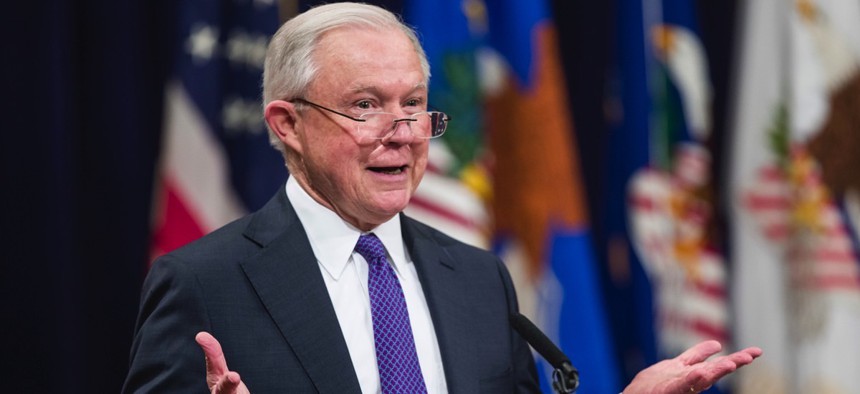DOJ Chases Positive Overdose Numbers With More Funding

Attorney General Jeff Sessions announces new strategic actions to combat the opioid crisis at the Department of Justice's National Opioid Summit in Washington, D.C. on Thursday. Alex Brandon / AP Photo
Attorney General Jeff Sessions announced a new “strike force” to investigate and prosecute prescription opioid abuse in Appalachia.
WASHINGTON — The Department of Justice is doling out $69.7 million to help states and localities with opioid enforcement and treatment, after preliminary data from the Centers for Disease Control and Prevention showed a modest downturn in drug overdose deaths.
Attorney General Jeff Sessions announced Thursday that the funding is for criminal investigations in states hardest hit by the crisis, as well as counseling, foster care, legal services, and law enforcement and school personnel training to help people addicted to drugs.
About 72,000 Americans died from drug overdoses in 2017, which was a record number. But between September 2017 and March 2018 there was a small drop in deaths, according to CDC’s National Center for Health Statistics.
“The opioid epidemic across America is one that has had tremendous impact on our cities, and collectively we are grateful for the additional funding announced today. As with many addiction problems in our society, we know we cannot arrest our way out of this problem,” Rick Myers, executive director of the Major Cities Chiefs Association, told Route Fifty.
Instead, Myers said that it makes sense to put money into treatment programs that keeps addicts out of jail.
Of the new opioid money, $27.9 million will go to 17 state law enforcement task forces through the Community Oriented Policing Services, or COPS, Office’s Anti-Heroin Task Force Program. That’s two years of funding for agencies’ heroin and opioid investigations in states with high per-capita levels of primary treatment admissions for overdoses.
The Mississippi Bureau of Narcotics will receive the largest award of $2.98 million, followed by the Massachusetts Department of the Attorney General at $2.95 million, and the New Jersey Department of Law and Public Safety at $2.87 million.
Another $7.2 million will go to nine state agencies—ones that regularly seize precursor chemicals, finished methamphetamine, laboratories and dumps—through the COPS Anti-Methamphetamine Program. The Kentucky State Police, South Dakota Attorney General, and Wisconsin Department of Justice will all receive the largest award of $1.03 million.
A final $34.6 million will go toward treatment and assistance through the Office of Victims of Crime. Of that, $29.8 million will be awarded to 41 sites and a technical service provider helping young people.
The maximum site grant of $750,000 is going to 12 sites including the Cook Inlet Tribal Council, Inc. in Alaska, Family Service of Rhode Island, San Antonio Council on Alcohol and Drug Abuse in Texas, and Child Protect of Mercer County, Inc. in West Virginia. Technical service provider JBS International, Inc. will receive $2.5 million.
DOJ will transfer $4.8 million to the Bureau of Justice Assistance to support partnerships between victim service providers and first responders who encounter overdoses where children are present.
“While the total funds announced will have limited impact when spread across the country, it demonstrates that DOJ understands the severity of the problem and is committed to assisting local policing in this effort,” Myers said.
On Wednesday, President Trump signed a package of bills aimed at making opioid addiction treatment more accessible, including through the Medicaid and Medicare programs. The legislation also aims to help crack down on the trafficking of fentanyl and carfentanil into the U.S., and increases research into opioid alternatives. Critics argued that while the package created small grant programs, not enough funding was included for expanding opioid treatment—funding that will come through the appropriations process.
Sessions also announced the creation of the Appalachian Regional Prescription Opioid, or ARPO, Strike Force, made up of 12 opioid fraud prosecutors—each with a team of federal agents. Appalachia has seen “tragically high rates of addiction and overdose,” he said.
ARPO will be based primarily out of Cincinnati and Nashville, Tennessee, and use FBI resources while working with the U.S. Postal Inspection Service, IRS Criminal Investigation and State Medicaid Fraud Control Units.
“They will help us find the doctors, pharmacists, and other medical professionals who are flooding our streets with drugs—and put them behind bars,” Sessions said. “We will be relentless, we will continue to get smarter and better at our work.”
Much of the crisis has been fueled by the medical community overprescribing addictive opioids to mitigate pain, so a strike force addressing the beginning of the cycle is promising, Myers said.
The Trump administration aims to reduce opioid prescriptions by one-third in three years, and they’ve decreased 12 percent in the first eight months of 2018, according to the Drug Enforcement Administration’s national audit.
“The strike force model is a proven mechanism to target illicit conduct and hold accountable criminals involved in illegal opioid prescription and distribution schemes,” said Gary Cantrell, deputy inspector general for investigations in Health and Human Services Office of Inspector General, in a statement.
Dave Nyczepir is a News Editor at Government Executive’s Route Fifty and is based in Washington, D.C.
NEXT STORY: If Parents Get Deported, Who Gets Their Children?






